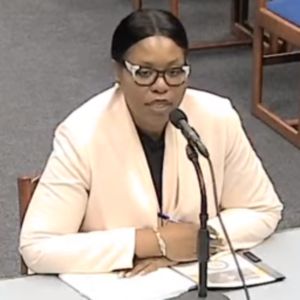Columnist Johanna Neumann: Massachusetts can be the next state to commit to 100% clean energy
| Published: 02-15-2023 8:31 PM |
Here’s why Massachusetts should commit to powering our state with 100% clean and renewable energy.
Our nation is continuing a remarkable transition to clean, renewable energy. Last year, solar, wind and other renewable energy sources provided nearly three-quarters of new electrical generating capacity.
Meanwhile, clean energy tax credits, a key part of the Biden administration and Congress’ affordable clean energy plan, went into effect last month. These tax credits have been widely touted as a game-changer in growing clean energy because they lower the consumer cost of many clean energy technologies.
New federal tax credits make it more affordable for Americans to transition to clean energy.
If you want to go solar, you can get 30% of the costs covered. There is no cap. The same is now true for battery storage, so you can save your solar energy for a cloudy day. Solar-powered water heaters are covered, too.
There is also now a tax credit for 30% of the cost of a heat pump or heat pump water heater, up to a maximum value of $2,000 in a year. You can get a 30% tax credit for many appliance and energy efficiency upgrades, up to a maximum of $600 per year.
For electric vehicles, there are income limits, price restrictions on the total cost of the car, and manufacturing requirements that impact who is eligible and which cars are covered. But since many of the restrictions do not apply to leased vehicles, if you want an electric vehicle but don’t qualify for the tax credits, leasing could be an appealing option.
Many of the technologies incentivized by the tax credits are also eligible for state-level rebates, which can lower the cost even more. So, if you haven’t made a plan yet for how to make your home a clean energy home, now’s a good time to get started so that you can maximize these tax credits.
Article continues after...
Yesterday's Most Read Articles
 A Waterfront revival: Two years after buying closed tavern, Holyoke couple set to open new event venue
A Waterfront revival: Two years after buying closed tavern, Holyoke couple set to open new event venue
 Island superintendent picked to lead Amherst-Pelham region schools
Island superintendent picked to lead Amherst-Pelham region schools
 Music key to Northampton’s downtown revival: State’s top economic development leader tours city
Music key to Northampton’s downtown revival: State’s top economic development leader tours city
 Pro-Palestinian encampment disperses at UMass, but protests continue
Pro-Palestinian encampment disperses at UMass, but protests continue
 Area property deed transfers, May 2
Area property deed transfers, May 2
 Amherst council hears call to scale back Jones work
Amherst council hears call to scale back Jones work
Decades ago, it may have seemed far-fetched that Massachusetts could meet all its energy needs with clean and renewable resources including the sun and the wind and the warmth of the Earth, but that’s not the case anymore. Technologies continue to increase and costs have come down.
Last week Minnesota became the 11th state to pass legislation committing that state to phasing out fossil fuels.
Meanwhile, Massachusetts is lagging behind. Our state commitment to renewable electricity currently caps out at 40% by 2030, with modest 1% additions each year after that. The sooner Massachusetts joins the 100% club, the better it’ll be for our health and our environment.
As historic investments in energy efficiency and clean energy continue to roll, I hope state lawmakers build on the federal progress by setting a goal of meeting all our state’s energy needs with 100% clean, renewable energy. H.D. 3348 introduced by state Reps. Marjorie Decker and Sean Garballey and cosponsored by state Rep. Lindsay Sabadosa, D-Northampton, would do just that. If passed, the bill would transition the commonwealth to 100% clean energy for electricity by 2035 and 100% clean energy for the building sector and transportation sector by 2045.
The barriers to reaching 100% renewable energy are political hurdles. After all, Massachusetts’ renewable energy resources are abundant. Offshore wind alone could meet all of our state’s electricity needs many times over, and when you factor in the abundance of solar and onshore wind in Massachusetts and the improvements in battery storage technology, it becomes clear that we have the power.
And we’re increasingly tapping it. Massachusetts produced more than 13 times as much renewable electricity from the sun and the wind in 2021 as it did in 2012. Renewables have grown to provide 9% of our state’s electricity. Wind power has more than doubled and solar power has grown nearly 200-fold since 2012. But there’s so much more to do.
With the growth of clean energy comes the promise of a better future: less pollution and greater energy independence and self-reliance.
So, it’s really just a matter of making the choice of what our energy future will be. Will we choose continued dependence on fossil fuels that harm our health and our environment, or will we choose a different path?
In this new year, buoyed by historic federal clean energy tax credits, it’s time for state policymakers to seize the opportunity, build on the progress, and choose a clean energy future for the sake of our planet, health and future.
Johanna Neumann of Amherst has spent the past two decades working to protect our air, water and open spaces, defend consumers in the marketplace, and advance a more sustainable economy and democratic society. She can be reached at columnists@gazettenet.com.

 Guest columnist Mariel E. Addis: Pride and prejudice
Guest columnist Mariel E. Addis: Pride and prejudice Guest columnist Gene Stamell: We know what we know
Guest columnist Gene Stamell: We know what we know Jennifer Dieringer: Budget must serve whole city
Jennifer Dieringer: Budget must serve whole city Ken Rosenthal: Time to change direction on Jones Library
Ken Rosenthal: Time to change direction on Jones Library
